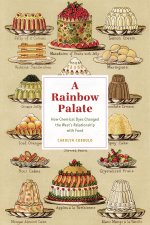A Rainbow Palate How Chemical Dyes Changed the West's Relationship with Food

Author: Carolyn Cobbold (Darwin 2011)
Publisher: University of Chicago Press
Aniline and ado dyes were the first of many novel substances that chemists began to synthesise on an industrial scale, and by the 1900s, a wave of bright coal tar dyes had begun to transform the Western world. Originally intended for textiles, the new dyes soon permeated daily life in unexpected ways, and by the time risks and uncertainties began to surface, they were being used in everything including food. A Rainbow Palate examines how chemists in Europe and the US manoeuvered themselves to become instrumental players in new regimes of food production, regulation and quality testing. As increasing industrialisation, international trade, and competition led to mounting concerns about food adulteration, manufacturers, politicians and the public all invoked chemists to represent their interests. The widespread use of new chemical substances influenced perceptions and understanding of food, science, and technology, as well as trust in science and scientists. Because the new dyes were among the earliest contested chemical additives in food, the battles over their use offer striking insights and parallels into today's international struggles surrounding food and chemical regulation.
In a vivid history of processed food, food fear and the role of new food experts at the turn of the twentieth century, this book shows how chemical dyes reshaped our world and the food we eat.